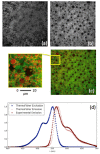Imaging of targeted lipid microbubbles to detect cancer cells using third harmonic generation microscopy
- PMID: 27446711
- PMCID: PMC4948635
- DOI: 10.1364/BOE.7.002849
Imaging of targeted lipid microbubbles to detect cancer cells using third harmonic generation microscopy
Abstract
The use of receptor-targeted lipid microbubbles imaged by ultrasound is an innovative method of detecting and localizing disease. However, since ultrasound requires a medium between the transducer and the object being imaged, it is impractical to apply to an exposed surface in a surgical setting where sterile fields need be maintained and ultrasound gel may cause the bubbles to collapse. Multiphoton microscopy (MPM) is an emerging tool for accurate, label-free imaging of tissues and cells with high resolution and contrast. We have recently determined a novel application of MPM to be used for detecting targeted microbubble adherence to the upregulated plectin-receptor on pancreatic tumor cells. Specifically, the third-harmonic generation response can be used to detect bound microbubbles to various cell types presenting MPM as an alternative and useful imaging method. This is an interesting technique that can potentially be translated as a diagnostic tool for the early detection of cancer and inflammatory disorders.
Keywords: (020.4180) Multiphoton processes; (170.1610) Clinical applications; (190.1900) Diagnostic applications of nonlinear optics; (320.7090) Ultrafast lasers.
Figures





References
LinkOut - more resources
Full Text Sources
Other Literature Sources
